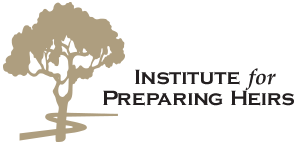Executors, Trustees & Beneficiaries: Honoring The Intent, The Law And Emerging Trends

“OVER 30 YEARS AGO, my mother asked me to be the executor of her estate. Her request deeply honored me and I offered a knee jerk response, respectfully and dutifully saying, ‘Of course, Mom.’ I was not thinking carefully before I answered her. I thought this was going to be a simple, easily made decision.” – Paul Schwan, from the Foreword of book from the Institute for Preparing Heirs entitled, Executors, Trustees & Beneficiaries: Honoring The Intent, The Law and Emerging Trends.
This is the first in a series of articles based upon the new book, Executors, Trustees & Beneficiaries: Honoring The Intent, The Law and Emerging Trends from the Institute for Preparing Heirs. This Q&A book offers new thinking and new tools designed to expand the family wealth conversation beyond the legal and fiduciary responsibilities of executors and trustees. This book introduces families and their trusted advisors to new inheritance conversations that give meaning and purpose to family wealth, and gives new insight and guidance to professional advisors in preparing wills and trusts. It explores the relationships between the asset builders, their trusted advisors, those chosen to be executors or trustees, and the beneficiaries who ultimately benefit.
We begin this series with what wealth builders need to know before drafting their wills and trusts, choosing an executor and/or trustee, and naming beneficiaries.
Successful families in transition
According to the authors of Executors, Trustees & Beneficiaries: Honoring The Intent, The Law and Emerging Trends, Vic Preisser and Vanessa Terzian, “Many successful individuals go through life focused on building prosperity, caring for their families and striving to be good parents. As successes accumulate, wealth builders shift their attention to the transition of that wealth to their children or others they hold dear. They create wills and trusts to address issues of transitioning control of wealth . . . control awarded to those whose competence they value—family members, fellow workers who helped build the assets, institutions, philanthropies, specific charities, and yes, even the government.”
The authors make the case that it’s just as important for families to prepare their heirs and beneficiaries to receive and manage the wealth as it is to prepare their assets for transfer. Estate planners and attorneys are skilled at writing the legal language creating a will or trust; the problems arise not with language but with the family. The authors write: “Heirs prepared for wealth and responsibility are likely to do well with trustees and executors, and are likely to be good executors themselves, and almost certainly evolve into good beneficiaries.”
What studies tell us about estate transfers
Studies have shown that most estates do now survive the first one to three generations, post-wealth transition. The family loses control of its assets and family unity is disrupted. The main causes are driven by three factors:
- Breakdown of trust and communication within the family
- Unprepared heirs
- Lack of an agreed upon family wealth mission for the assets being transitioned
Rarely does a family break apart post-estate transfer because of errors in the estate documents.
Rethinking wills and trusts
How can a will or trust be used to improve a wealth builder’s odds of a successful wealth transfer? It begins with families thinking—and talking—about its wealth in a much broader context than just the money.
Family wealth includes resources and assets in all forms—cash, bonds, equities, ownership interests, real property . . . as well as your family name, knowledge, health, spirituality, family unity, and support of community. – Institute for Preparing Heirs
Before the estate documents are drawn, families need to have new inheritance conversations centered on the meaning of “family” and purpose to the family wealth, considering the broader definition of wealth above. The entire family, including spouses, should participate in drafting a Family Wealth Mission Statement that contains members’ shared values and agreement upon how the wealth is be used today and in the future. This Statement is helpful for advisors to ensure the wishes of the wealth builder’s family are honored when drawing up wills and trusts as well as providing insight to future executors, trustees and beneficiaries.
The new role of the trusted advisor
What guidance can the trusted advisor give affluent families? The following are excerpts from a true story of how one enlightened wealth advisor engages the entire client family in the estate planning process:
“During a portfolio review meeting, Katherine L., a financial advisor, asked her clients if they would mind helping her fill in their family tree, including the names of all of their children and the children’s spouses and children and grandchildren as well as the clients’ parents. She also asked for the names of their executor and trustee along with the family’s other trusted advisors (estate attorney, CPA, insurance advisor). She even included the names of the family pets!
Katherine explained why knowing the members of their entire family and its advisory team would help her serve them better. She made them aware of a few of the pitfalls other families have faced while transferring assets to unprepared children, grandchildren, and other family members—pitfalls that had little to do with the estate documents. … Katherine offered books and articles on the topic for family members to read and discuss in a family meeting setting. . . .
Katherine went on to explain the importance of preparing their heirs for their roles as beneficiaries. (And the importance of preparing for their role as beneficiaries if their parents plan to transfer assets to them.) … Katherine suggested setting up a meeting with the family’s estate planning attorney and CPA, with Katherine preparing the agenda. She wanted the adult children to learn more about what the advisors do for the family today and review the structure of the estate planning documents and investment plans. She also planned to discuss the future roles of executor, trustee, and beneficiary and what those roles involved. She reassured her clients that the amount of the estate would not be disclosed at this time. Her goal was to make sure the children were comfortable with, and had confidence in, their family’s team of advisors and their family’s intention for the future transition of the assets. . . . “
The next article will look at the role of executors.

